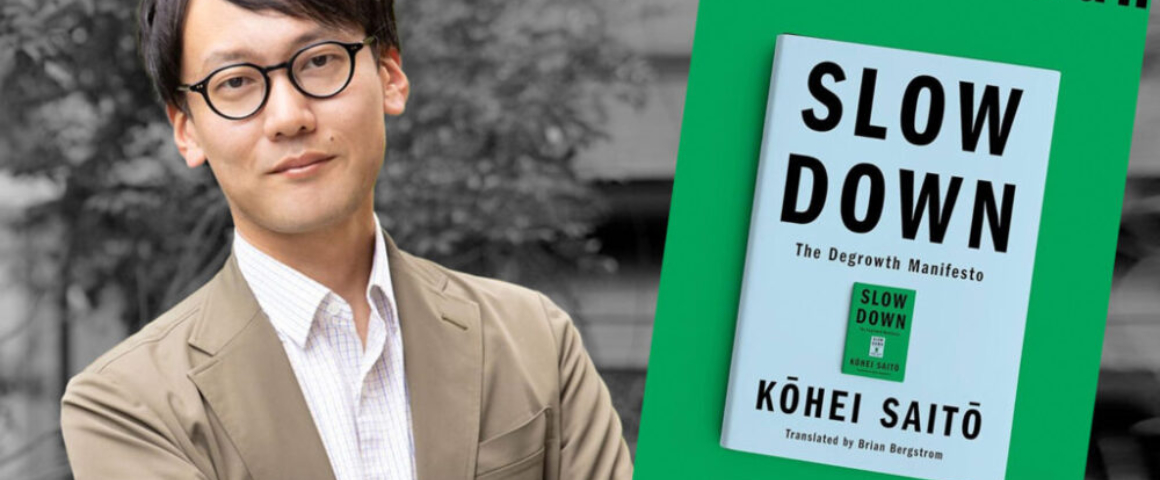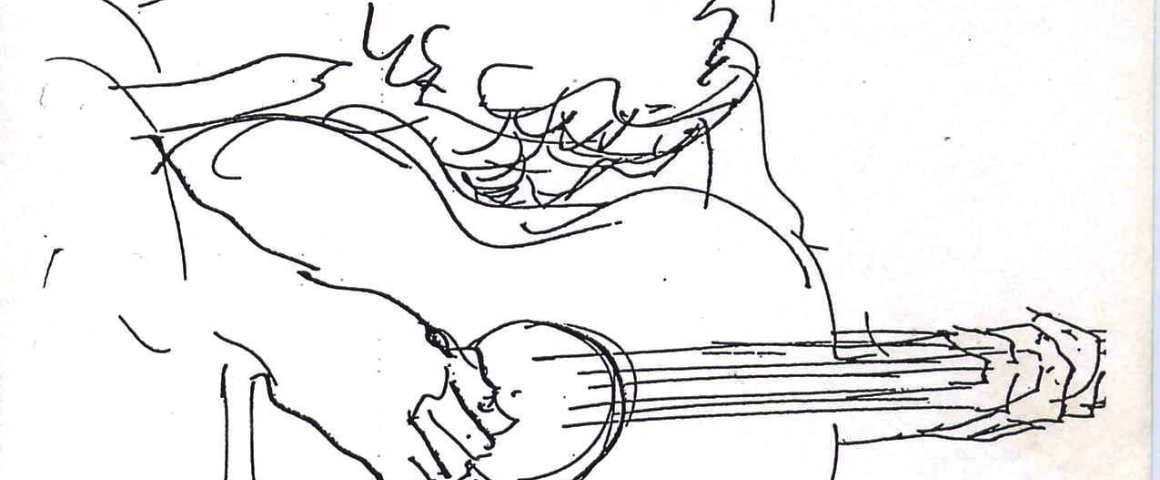By Richard Mullen
Kohei Saito’s book on degrowth communism was an unlikely bestseller in 2020, with half a million copies sold in Japan. This is an oft-cited line introducing Saito’s works in the West, in anticipation of the English translations. After the English translation of Marx in the Anthropocene coming out last year, this year saw the publication of Slow Down: The Degrowth Manifesto (Penguin Random House, 2024). The Manifesto is a short, accessible read with most of the strong and weak sides of Saito’s previous book reiterated in a new format.
Saito makes it clear early on that he wants to relieve the communism in his “degrowth communism” of historical baggage: none of the actually existing socialism of the 20th century goes into his theory. The plan is “a more democratic, egalitarian and sustainable vision of a new steady-state economy,” as opposed to “undemocratic state socialism controlled by the state bureaucrats.” This, combined with Saito’s departure from historical materialism (Saito claims Marx abandoned “hist-mat” himself) makes for a vision of communism bordering on idealism at best.
It is not to say that Saito does not make good insights into the causes and the reality of the climate crisis: the Manifesto is an excellent resource for conversations around climate and the capitalist treatment of the environment. In his trademark derivative maxim, “[T]he Sustainable Development Goals (SDGs) are the opiate of the masses,” he makes it clear early on that the current international climate agenda of states, industry and finance is a smokescreen, and that no solutions can be expected from it.
Through data and accessible language, Saito explains that the climate crisis is an ongoing process, and that this process is being accelerated by capital. For the reader in the developed world, he reminds us constantly of externalization: the imperial standards of living which are maintained via the sacrifice of the Global South, which is often hard to see from the imperial core. When speaking of workers’ exploitation in the Global North, it is outlined as a result of the Global South reaching its exploitation limit, and the North proceeding with exploitation within itself.
In the spirit of degrowth, Saito proceeds to speak of the limits to growth, planetary boundaries and unsustainability of any growth, be it the one outlined in Green New Deal or one envisioned with SDGs. In this discussion, it is valuable to recognize the metrics of growth, such as gross domestic product (GDP), as a way to simplify and once again obfuscate the relations of capital and environment. “Sustainable industry” is not about allowing a reduction in consumption of resources so much as it is about allowing the production of more with the same consumption: this is again the tendency of capital.
Once Saito establishes that capitalist business-as-usual, with all of its greenwashed appendages, will not solve the climate crisis (which is a conclusion we can all get behind, and Saito’s arguments serve as excellent references), he draws a diagram for potential futures, akin to the infamous, cross-shaped political compass. In the top right corner, with strong state power and high inequality, lies Climate Fascism. In the bottom right, with weak state power and high inequality lies Barbarism. On the left side, the top corner (strong state, high equality) is Climate Maoism, and in the bottom (weak state, high equality) is “X”: later to be revealed, of course, to be climate communism. For it, Saito writes, “There must be a fourth way, a way to resist both a slide into barbarism and some form of autocratic nationalism. It’s not impossible to implement democratic forms of mutual aid that don’t rely on a strong nation to function, instead relying on individuals to voluntarily develop strategies for combating climate change on their own. This would be a just, sustainable future society.” The next paragraph gives a promise: “The aim of the rest of this book will be to elucidate the exact nature of this unknown future and how to achieve it.”
Saito proceeds to show that a degrowth capitalism is not a sensible option. Then he proceeds with the main thesis of his work: reinventing Marx as a degrowth thinker. He explains how Marx started as a productivist and then realized the errors of his ways. As interesting as it is to give Marx new reading perspectives, this one relies on a thin thread of selective readings. For the sake of argument, the reader might accept this thesis generously, and ask: how do we now reach this communism Saito’s Marx envisioned? Is there a demographic with revolutionary potential, and is there a revolutionary party? (No.)
Technology won’t do it; adventurism won’t do it; individual choices won’t do it. But… participatory socialism? Here Saito, Thomas Piketty and Saito’s reading of late Marx come together in a vision of commons and workers’ self-management. Again, this is more of an outcome than a process for achieving it: how to reach it from the current position in the development of capitalism? Again, in his vision, Saito talks more of what should be done in the new system to make it degrowth-centred, and less of the change necessary to take control in the first place. In this section, he points at social movements and local organizing as a space of learning, but without a logical line of reasoning on how it scales. “As community and social movements gain strength, politicians will become afraid not to instigate greater and greater changes. Barcelona’s city government and France’s citizens’ assemblies are cases in point,” says Saito, somewhat unconvincingly.
In the conclusion, Saito attempts to show an outline of mechanism he sees as necessary for the change he envisions, and it relies on 3.5 percent of the population. Saito here quotes Erica Chenoweth’s work, according to which “3.5 percent of [the] population must rise up sincerely and non-violently to bring about a major change to society.” Saito chooses to serve the example of the Occupy Wall Street movement here. “Yet these resistance movements have had major impacts on society. Demonstrations have numbered in the several thousands to millions. Videos of these movements have been shared millions and even billions of times on social media. If it were an election, this would translate into billions of votes. This is the road to revolution.”
This odd perception of the road to revolution serves as a good reminder to the reader to read Vincent Bevins’s new book If We Burn: The Mass Protest Decade and the Missing Revolution (Wildfire, 2023) with, or perhaps, instead of Saito’s.
Socialist Voice (Ireland)
Support socialist media!
If you found this article useful, please consider donating to People’s Voice or purchasing a subscription so that you get every issue of Canada’s leading socialist publication delivered to your door or inbox!
For over 100 years, we have been 100% reader-supported, with no corporate or government funding.




